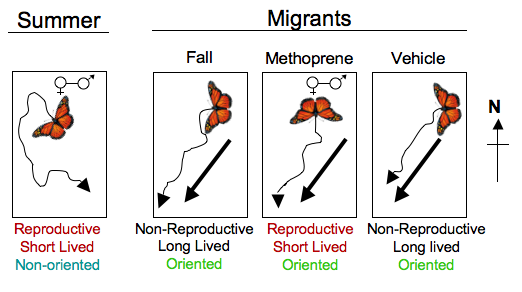Migrants
In the fall, decreasing daylength, cooler temperatures, and aging milkweed (genus Asclepias; the larval food plant) contribute to the environmental events that trigger the migratory generation (Goehring and Oberhauser, 2002). Migrant flight is directional; they orient to the south/southwest using a time-compensated sun compass.
Thanks to a deficiency in juvenile hormone (JH), migrants are reproductively inactive (a state called diapause), have increased abdominal fat stores, and live longer. They remain in this limbo throughout the winter until warmer temperatures and longer day lengths coax them out of diapause. Then they mate, fly northward, and lay eggs on newly emerging milkweed plants.
The summer butterflies hatched from these eggs are reproductively active and short-lived. In two successive generations, these monarchs leapfrog north from the overwintering sites to repopulate their entire range. We have found in flight simulator studies that at the end of summer—quite unlike the fall migrants—monarchs don’t exhibit oriented flight at all (Zhu et al., 2009).
What are the physiological and molecular differences between migratory and non-migratory monarchs? How is the switch to reproductive diapause triggered, and what are the genetics underlying that change?
Pressing Pause
As discussed above, JH is one of the defining differences between summer butterflies and fall migrants: migrants are deficient in JH. Many migratory behaviors are regulated by JH. Migrants need to live longer to reach their destinations, they can’t be distracted by reproduction, and they need extra energy stores—continued JH deficiency accomplishes all those things.
But what about time-compensated sun compass orientation, the behavioral hallmark of monarch migration? Does that, too, require a persistent lack of JH?
To find out, we treated fall migrants with methoprene, a potent JH analog, inducing them into a reproductively active state (Zhu et al., 2009). We tested these treated butterflies for oriented flight in a flight simulator, and compared them to normal summer butterflies and normal fall butterflies. Although their reproductive state matched the summer butterflies, their flight behavior continued to match the migrants—they exhibited directional flight, orienting significantly to the southwest.

To test for time-compensation in methoprene-treated fall monarchs, we compared butterflies kept on a normal light-dark cycle with butterflies kept on a 6-hour delayed light-dark cycle. Just like normal fall monarchs, the methoprene-treated migrants adjusted their bearing based on the 6-hour delay, demonstrating true time-compensated sun compass orientation.
So while JH deficiency regulates many migratory behaviors, it is not responsible for the maintenance of directional flight and time- compensated sun compass orientation. Increasing JH in migrants does not disrupt directed, time-compensated flight.